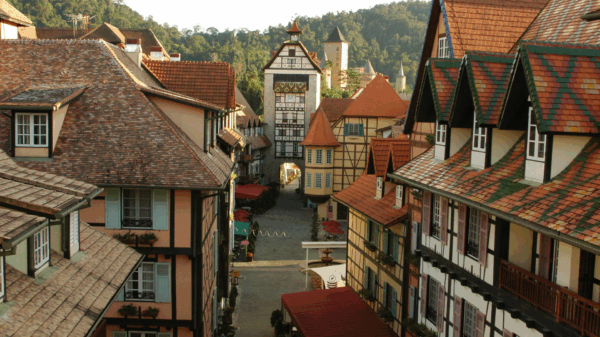After almost 30 years of commercial availability, virtual reality is having its moment in the sun. Consumer-level VR devices have marketers and tour industry insiders racing to get the most out of this exciting, immersive tech. But while VR developers explore the possibilities of immersing customers in foreign locales from the comfort of their homes, augmented reality (AR) and mixed reality developers are quietly building the future of travel.
AR takes the real world around us and expands it, creating endless opportunities to share digital information that’s relevant to our environments. A single location can have as many AR layers atop it as there are apps to display them, each creating interactive digital elements that can be seen through device cameras or smart glasses. In other words, users remain in the real world while exploring AR, and the real world is where travel experiences live.

VR, on the other hand, generally removes users from their surroundings entirely, immersing them in 3D environments. As a result, while VR’s most promising travel applications are in marketing, AR has the potential to make travel easier, more convenient, more educational, and safer, all by enhancing the experience rather than replacing it.
That’s even truer when you consider mixed reality (or merged reality), which combines the two to embed virtual objects in real-world environments. More than just images displayed in a layer atop the real-world environment, mixed reality lets you interact with objects that exist virtually in the real world.
Here’s an example of a simple mixed reality demo for an app that helps you find someone in a crowd. Rather than trying to locate them on a 2D map, the app puts a marker over their location, so every time you look at the world through your phone screen or smart glasses, you can see exactly where they are:
It’s a small, common-sense integration that has the potential to be a lifesaver.
While augmented reality technology has been popular for a few years — you probably noticed it with the Pokemon Go craze — we’re in the midst of a particularly exciting moment for AR. Apple’s ARKit provides app developers with a selection of powerful AR tools. Using an iOS device’s built-in sensors, app developers can map horizontal planes, light sources and other details that make mixed-reality integrations more convincing than ever — and more accessible to millions of iOS users.
The travel sector stands to benefit from what could be an explosion of augmented reality adoption. Travel companies are already embracing the educational, marketing and entertainment possibilities of augmented reality. Here are some of the forerunners:
Skadi
Skadi is a ski guide for solo adventurers, one that can help skiers find the routes best-suited to their skill levels or escape habitual ruts. It maps the routes of participating ski resorts and offers suggestions to users based on skill, adventurousness and preferences. It’s an alternative for skiers who want more structure than the average solo daytrip but less than a ski program or backcountry guide.
“Our aim,” says app developer Ivan Mikhaylov in an interview with The Telegraph, “is to encourage skiers and snowboarders to explore more. Without Skadi, most visitors to a resort only tackle about 15 per cent of the ski area. Skadi opens that up and encourages visitors to try new runs.”
Skadi is also a gamified take on skiing. Users can track down virtual coins and creatures from Norse mythology on the ski hill, get their own skiing stats and share their achievements. And because Skadi uses voice guidance and works offline, there’s no need to worry about tech-obsessed skiers wandering around looking for bars of reception with their eyes glued to their screens.
Visit Orlando
Visit Orlando is a local recommendations app powered up with both artificial intelligence augmented reality.
Using technology driven by IBM’s Watson AI, users can search for crowdsourced recommendations nearby. AR overlays let them see exactly where to find dining, shopping and other options in the world around them.
Visit Orlando has its own simplified game elements, too, but the real feature is customized recommendations everywhere you look.
App in the Air
App in the Air shows how AR apps can be used for eminently practical purposes, flashy as they might be. First, it helps users find flights to book. Then it shows them a plane’s seats at true scale so they can decide which option will have the size, leg room and comfort they’ll need.
Those are handy features, but the best may also be the simplest: it allows users to directly compare their carry-on luggage to the airline’s permitted sizes. If it could also measure whether a user’s toiletries will fit in a regulation-sized one quart bag, it would take all the guess work out of air travel.
And More
Travel’s AR boom is just beginning, so new apps and concepts are arriving daily. Some, like Jerusalem Awakens, will allow users to enhance real world historical tours with reimaginings of the past. Others will bring our industry events into the future. For each way augmented reality could disrupt the industry, there are a dozen more enhancements it could bring innovative tour and travel companies.
Search The Blog
Categories
Most Popular Articles
- 16 Innovative Tourism Business Ideas and Trends for 2025
- Your Marketing Mix: the 7 Ps of Travel and Tourism Marketing
- Mastering Email Marketing: A Step-by-Step Guide for Tour and Activity Companies
- Special Interest Tourism: Find Your Niche
- Should You Pass Booking Fees to Your Customers? Pros and Cons for Tour Operators





